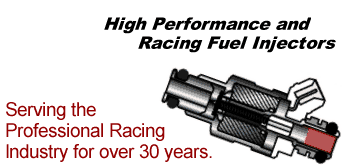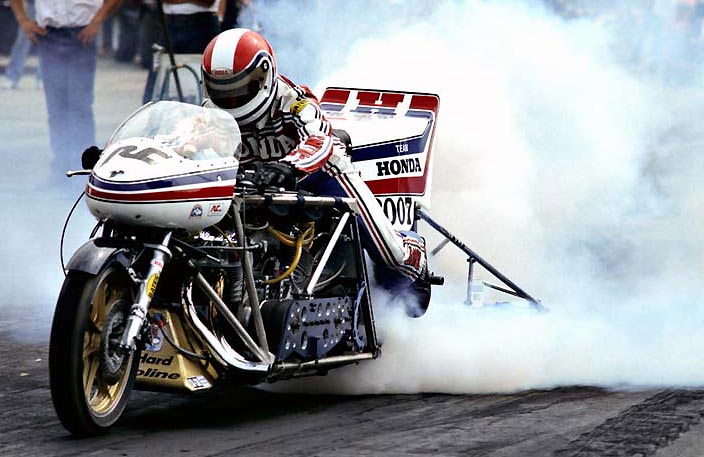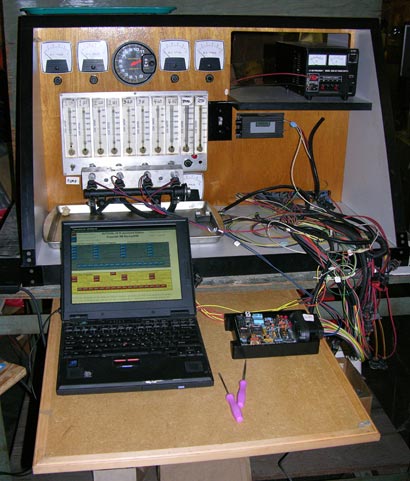Professional Fuel Injector Pulsewidth Calculator

This
calculator will generate pulsewidth values for specific rpms, from idle
to peak speeds. The constants used are 160 CFM per 100 HP, and an 85%
duty cycle for maximum injector pulsewidth. Injectors will go static at
about a 92% duty cycle and should be sized for an 80% duty cycle to
leave some "wiggle" room.
Beyond the 85% figure
horsepower can actually drop as the pintles or discs in the injectors
are essentially "floating", trying to open and close before they can
complete each event. At this point the injectors actually put out less
fuel until they are fully pulsed static and then the final output goes
to 90% of their rated capacity. Injectors should not be pulsed beyond
an 85% duty cycle.
Injectors are rated when
shorted open @ 43.5 psi (3 Bar). The injectors will, when pulsed, only
achieve 90% of this figure. Also calculated is the expected injector
ccm flow at the selected rpm and load (KPa).

RB Racing only uses RC Engineering Fuel Injectors, either high or low impedance with ratings up to 1600cc/mim. We have known Russ Collins,
who was inducted into the Motorcycle Hall of Fame, since 1974. Like the
Don McLean song "Bye-Bye Miss American Pie"....motorcycle drag racing
died and hasn't progressed technically since Russ Collins retired. Only
one Buddy Holly...only one Russ Collins. The "Sorcerer", Russ's
Nitromethane burning "V8" with two SOHC Hondas held the Top Fuel record
for 12 years.
Doubles, triples, V8's, Hilborn
Injection, Nitro, Superchargers, rear facing zoomies, Cobra Motors,
Golden Rods, Sidewinders, Webers, Strokers, Flowbenches, Dynos, 4-1's,
rotational firing collectors, magnetos, belt drives, slipper clutches,
data acquistion, white leathers, professional presentation, feathered
hats and a victory cigar.
If you ever wonder
where Terry Vance and Byron Hines got their start....Well, everyone
needs someone to lead the way. Anyone can copy.
Injector Wet Flowbench

At RB Racing we wet flow our RSR Fuel Injection
Systems to see the actual horsepower outputs. We can test specific fuel
pumps, regulators, injectors and set fuel pressures to meet the
particular requirement. We also simulate temperture changes in the
engine as well as the inlet air temperatues. Variables on our RSR Wet
Flowbench are Air Temp, Engine Temp, TPS, O2, Manifold Pressure, RPM,
start functions, battery voltage, fuel pump size ( 300, 400, 600, 1000
hp), and fuel pressure. We can visually monitor horsepower output and
bypass fuel. All RSR ECU's are tested on the flowbench prior to
shipment.
Volumetric efficiencies are related to
inlet tract design and inertia considerations. At idle your V.E. might
be as low as 15% to 20% whereas at higher and peak rpms in some systems
V.E. can be 100% or greater. Typically full power or higher rpms are
calculated @ 85% V.E. as an average. V.E. usually rises quickly off of
idle as inertial filling takes place. If the inlet system is too
restrictive then V.E.'s can fall off as the rpms pass their most
efficient flow.
Mach Indexes in the inlet system need to be considered in engine design.
Professional Fuel Injector Calculator (Idle & Peak Values)


